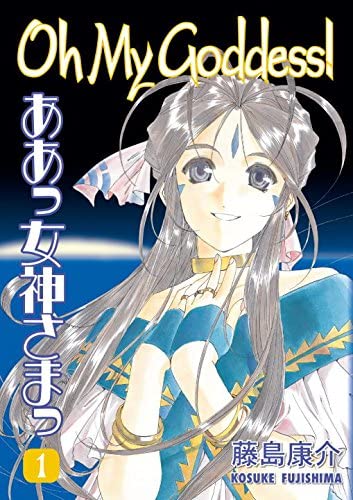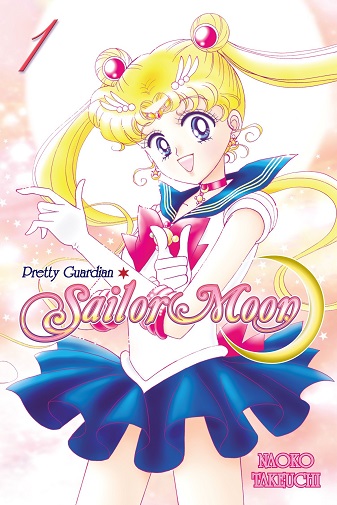If you were involved in an American anime club in the 2000’s like myself, you were more than likely exposed to the anime adaptation of Oh My Goddess, as it was one of the most commonly shown anime series at club gatherings. While this has common at that time, the manga had actually been running since the late 1980’s. Kosuke Fujishima’s Oh My Goddess had an immensely impressive run that lasted from 1988 to 2014, with the series being collected into 48 volumes. In America, we had an odd introduction to the manga; Dark Horse picked up the license and began to sell the series one chapter at a time in floppy American Comic format. The first 112 chapters were released this way between 1994 and 2004. Dark Horse in 1996 decided to collect the series into volumes like what had been done in Japan, and sell the series in a more traditional manga format in addition to the Americanized floppy format. The series’s final volume saw release stateside a year after the manga ended in Japan, so fans in the Western Hemisphere did not have to wait too terribly long to see the conclusion of the story. Today we will explore what makes Oh My Goddess one of the wonders of the manga world.
The story begins on an ordinary night, college student Keiichi Morisato is sitting in his dorm hungry and gets the idea to order Chinese food over the phone, and accidentally dials a wrong number, connecting him to The Goddess Technical Helpline. This summons the goddess Belldandy, and she promises to grant Keiichi one wish of his choosing, to which he responds that he wishes a goddess like her would stay with him forever, to which Belldandy obliges. Since Keiichi’s dorm is male only, he is forced to move out and into an old, unused Buddhist temple, which becomes the pair’s home for the rest of the story. We see how Belldandy integrates herself into Keiichi’s life as a magical helper, a potential love interest and a friend. Belldandy must hide her powers from other humans and try to live a normal life with Keiichi when in public, with only a select few knowing her true origins. As the story progresses, more goddesses appear at the shrine and live with Keiichi that have a connection to Belldandy, and the plot thickens from there, mixing the daily lives of the characters, and the supernatural element that the goddesses bring to the table. The story masterfully mixes Keiichi’s life as a human and Belldandy’s life and the affairs of the worlds of heaven and hell. While the series is primarily a romantic comedy, there are story arcs that delve into the realm of motorcycle racing, supernatural battles, the politics of heaven and hell, slice of life and situational comedy.
With the narrative style of the manga being more character and relationship driven, coupled with the long, fourty-eight volume run of the series, the characters have plenty of time to be fleshed out, developed and have their dynamics with the rest of the cast full explored. Lets briefly take a look at some of the key characters without spoiling anything important. Our protagonist, Keiichi is a shy, mild mannered young adult who loves motorcycles. He is a part of his college’s Motor Club, where he builds, repairs and races motorcycles with his peers. Belldandy is a pure soul, filled with patience, kindness and compassion for all creatures. The story explores whether her devotion for Keiichi is due to his wish, or of her own personal interest. The developments to both Keiichi and Belldany’s characters around this concept are extremely well done, and really bring both of these characters to life. Some other key characters are Belldandy’s two sisters, Urd and Skuld. Urd is Belldandy’s older half-sister, who is only half-goddess by blood. Urd is a master chemist and apothecary, and loves concocting all sorts of odd potions and compounds to cause mischief. She is much more mischievous and silly than Belldandy and often uses that aspect of herself to playfully bother the other characters. She also has an affinity for the element of lightning. The youngest sister of the three, Skuld is a top class engineer, capable of creating all sorts of robots, machines and apparatuses with extreme ease. Her main creation is the guard robot, Banpei that serves as a security system for the shrine the characters live at. She has a much more child-like and inquisitive demeanor, and frequently squabbles with her eldest sister. All the major characters get tons of backstory as well as the aforementioned character development. By the end of the series, you will understand each of their origins, why they make the choices they do, and the events that made them who they are, both past and present.
The setting of Oh My Goddess is contemporary Japan at the time of publishing. With items such as cassette tapes and pop culture references relative to the time, the story does date itself a bit, but in a way that is charming and nostalgic. Much of the time spent in the story is spent in Japan with locales such as Keiichi’s college, Nekomi Institute of Technology, the shrine him and the goddesses reside, and other attractions in their town. As the story progresses, readers will be exposed to other, more supernatural settings, such as Valhalla (Heaven) and Niflheim (Hell), and will see how those tie in with the story’s primary characters. Much of the story’s mythology is borrowed from Norse mythology, such as the goddesses names and the names of the universe’s heaven and hell. With this combination of real to life and mythological settings, Oh My Goddess presents itself in a whimsical manner that will whisk the reader away to its world and create an experience that stays with them long after they have finished the series.
The art style of Oh My Goddess has its own progression. While the early volumes still capture that pretty and elegant aesthetic the series is going for, the early art of the series is admittedly a little rough around the edges, but after the few volumes Kosuke Fujishima’s art goes through a noticeable evolution into his signature style he is known for today. That being said, the character design is extremely well done throughout, and really accentuates who the characters are. The goddesses are instantly recognizable, even to manga fans who haven’t read the series and have only seen it in passing. All of the scenes with movement, such as the motorcycle races or the magical battles, all are super easy to follow and portray the movement extremely well. Those shots are drawn in a way that is intuitive for the reader to follow and envision how the action moves from panel A to panel B. There is also a lot of impressive background work to be witnessed in the series. The background work on the shrine the main characters reside in gives the panels a homey feeling, while the more supernatural and fantasy locations give a strong otherworldly and whimsical vibe off. Once Kosuke Fujishima’s art comes into its own after the first few volumes, readers are in for a visual treat that is the art of Oh My Goddess.
Oh My Goddess is part romantic comedy, part racing, part slice of life, part magical girl and 100% charming. The series delivers on all of these concepts in spades, and never cuts corners on one in favor of the other, which is something that gives it a wide appeal and has contributed to its longevity across the globe. The series has even seen sequels in the light novel, Oh My Goddess: First End (which I would also recommend for fans of the series) in 2007, and a sequel manga in, Aa Shūkatsu no Megami-sama, which just wrapped up in Japan in 2021. Considering the facts that the characters are memorable and endearing, the story arcs cover a little bit of everything, the lore is easy to delve into, and the world and locales are unforgettable, it is no wonder how Oh My Goddess became such a beloved series, as well as a wonder of the manga world.

